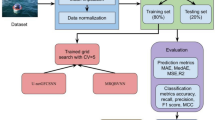Abstract
Marine growth impacts the stability and integrity of offshore structures, while simultaneously preventing inspection procedures. In consequence, companies need to employ specialists that manually assess each impacted part of the structure. Due to harsh sub-sea environments, acquiring large quantities of quality underwater data becomes difficult. To mitigate these challenges a new data augmentation algorithm is proposed that generates new images by performing localized crops on regions of interest from the original data, expanding the total size of the dataset approximately 6 times. This research also proposes a learning-based algorithm capable of automatically delineating marine growth in underwater images, achieving up to 0.389 IoU and 0.508 Dice Loss. Advances in this area contribute for reducing the manual labour necessary to schedule maintenance operations in man-made submerged structures, while increasing the reliability and automation of the process.
Access this chapter
Tax calculation will be finalised at checkout
Purchases are for personal use only
Similar content being viewed by others
References
Adumene, S., Ikue-John, H.: Offshore system safety and operational challenges in harsh arctic operations. J. Safety Sci. Resilience 3(2), 153–168 (2022). https://doi.org/10.1016/j.jnlssr.2022.02.001
Apolinario, M., Coutinho, R.: Understanding the biofouling of offshore and deep-sea structures. In: Hellio, C., Yebra, D. (eds.) Advances in Marine Antifouling Coatings and Technologies, pp. 132–147. Woodhead Publishing Series in Metals and Surface Engineering, Woodhead Publishing (2009). 10.1533/9781845696313.1.132
Badrinarayanan, V., Kendall, A., Cipolla, R.: Segnet: a deep convolutional encoder-decoder architecture for image segmentation. IEEE Trans. Pattern Anal. Mach. Intell. 39(12), 2481–2495 (2017). https://doi.org/10.1109/TPAMI.2016.2644615
Campos, D., Matos, A., Pinto, A.: Multi-domain inspection of offshore wind farms using an autonomous surface vehicle. SN Appli. Sci. 3 (2021). https://doi.org/10.1007/s42452-021-04451-5
Chan, F., Lam, F., Zhu, H.: Adaptive thresholding by variational method. IEEE Trans. Image Process. 7(3), 468–473 (1998). https://doi.org/10.1109/83.661196
Chen, L.C., Papandreou, G., Schroff, F., Adam, H.: Rethinking atrous convolution for semantic image segmentation. arXiv (2017). https://doi.org/10.48550/arXiv.1706.05587
Cheng, J., Xue, R., Lu, W., Jia, R.: Segmentation of medical images with canny operator and gvf snake model. In: 2008 7th World Congress on Intelligent Control and Automation. pp, 1777–1780 (2008). https://doi.org/10.1109/WCICA.2008.4593191
Dionísio, J.M.M., Pereira, P.N.A.A.S., Leite, P.N., Neves, F.S., Tavares, J.M.R.S., Pinto, A.M.: Nereon - an underwater dataset for monocular depth estimation. In: OCEANS 2023 - Limerick. pp. 1–7 (2023). https://doi.org/10.1109/OCEANSLimerick52467.2023.10244675
Drews-Jr, P., Nascimento, E., Botelho, S., Campos, M.: Underwater depth estimation and image restoration based on single images. IEEE Comput. Graph. Appli. 36, 24–35 (2016). https://doi.org/10.1109/MCG.2016.26
Drews-Jr, P., Souza, I., Maurell, I., Protas, E., Botelho, S.: Underwater image segmentation in the wild using deep learning. J. Brazilian Comput. Soc. 27 (2021). https://doi.org/10.1186/s13173-021-00117-7
He, K., Zhang, X., Ren, S., Sun, J.: Deep residual learning for image recognition. In: 2016 IEEE Conference on Computer Vision and Pattern Recognition (CVPR), pp. 770–778 (2016). https://doi.org/10.1109/CVPR.2016.90
Kingma, D.P., Ba, J.: Adam: A method for stochastic optimization. arXiv (2017). https://doi.org/10.48550/arXiv.1412.6980
Leite, P.N., Pinto, A.M.: Exploiting motion perception in depth estimation through a lightweight convolutional neural network. IEEE Access 9, 76056–76068 (2021). https://doi.org/10.1109/ACCESS.2021.3082697
Leite, P.N., Pinto, A.M.: Fusing heterogeneous tri-dimensional information for reconstructing submerged structures in harsh sub-sea environments. SSRN (2023). https://doi.org/10.2139/ssrn.4409685
Leite, P.N., Silva, R.J., Campos, D.F., Pinto, A.M.: Dense disparity maps from RGB and sparse depth information using deep regression models. In: Campilho, A., Karray, F., Wang, Z. (eds.) ICIAR 2020. LNCS, vol. 12131, pp. 379–392. Springer, Cham (2020). https://doi.org/10.1007/978-3-030-50347-5_33
Lloyd, S.: Least squares quantization in pcm. IEEE Trans. Inf. Theory 28(2), 129–137 (1982). https://doi.org/10.1109/TIT.1982.1056489
Mary Synthuja Jain Preetha, M., Padma Suresh, L., John Bosco, M.: Image segmentation using seeded region growing. In: 2012 International Conference on Computing, Electronics and Electrical Technologies (ICCEET), pp. 576–583 (2012). https://doi.org/10.1109/ICCEET.2012.6203897
Pinto, A.M., et al.: Atlantis coastal testbed: a near-real playground for the testing and validation of robotics for o &m. In: OCEANS 2023 - Limerick, pp. 1–5 (2023). https://doi.org/10.1109/OCEANSLimerick52467.2023.10244595
Pinto, A.M., et al.: Atlantis - the atlantic testing platform for maritime robotics. In: OCEANS 2021, San Diego - Porto, pp. 1–5 (2021). https://doi.org/10.23919/OCEANS44145.2021.9706059
Pinto, A.M., Matos, A.C.: Maresye: a hybrid imaging system for underwater robotic applications. Inform. Fusion 55, 16–29 (2020). https://doi.org/10.1016/j.inffus.2019.07.014
Pinto, A.M., Pinto, H., Matos, A.C.: A mosaicking approach for visual mapping of large-scale environments. In: 2016 International Conference on Autonomous Robot Systems and Competitions (ICARSC), pp. 87–93 (2016). https://doi.org/10.1109/ICARSC.2016.18
Ronneberger, O., Fischer, P., Brox, T.: U-Net: convolutional networks for biomedical image segmentation. In: Navab, N., Hornegger, J., Wells, W.M., Frangi, A.F. (eds.) MICCAI 2015. LNCS, vol. 9351, pp. 234–241. Springer, Cham (2015). https://doi.org/10.1007/978-3-319-24574-4_28
Silva, R., Matos, A., Pinto, A.M.: Multi-criteria metric to evaluate motion planners for underwater intervention. Auton, Robots 46, 971–983 (12 2022). https://doi.org/10.1007/s10514-022-10060-x
Simonyan, K., Zisserman, A.: Very deep convolutional networks for large-scale image recognition. arXiv (2015). https://doi.org/10.48550/arXiv.1409.1556
Skliris, N., Marsh, R., Srokosz, M., Aksenov, Y., Rynders, S., Fournier, N.: Assessing extreme environmental loads on offshore structures in the north sea from high-resolution ocean currents, waves and wind forecasting. J. Marine Sci. Eng. 9(10) (2021). https://doi.org/10.3390/jmse9101052
Zhou, Y., Wang, J., Li, B., Meng, Q., Rocco, E., Saiani, A.: Underwater scene segmentation by deep neural network. In: UK-RAS19 Conference: “Embedded Intelligence: Enabling & Supporting RAS Technologies” Proceedings (2019). https://doi.org/10.31256/UKRAS19.12
Acknowledgments
This work is partly funded by the Portuguese Government through the Fundação para a Ciência e a Tecnologia (FCT) within P.hD. grant 2020.06949.BD (to PNL), and by the European Union’s Horizon 2020 - The EU Framework Programme for Research and Innovation 2014-2020, under grant agreement No. 871571 (ATLANTIS).
Author information
Authors and Affiliations
Corresponding author
Editor information
Editors and Affiliations
Rights and permissions
Copyright information
© 2024 The Author(s), under exclusive license to Springer Nature Switzerland AG
About this paper
Cite this paper
Carvalho, J., Leite, P.N., Mina, J., Pinho, L., Gonçalves, E.P., Pinto, A.M. (2024). Artificial Intelligence for Automated Marine Growth Segmentation. In: Marques, L., Santos, C., Lima, J.L., Tardioli, D., Ferre, M. (eds) Robot 2023: Sixth Iberian Robotics Conference. ROBOT 2023. Lecture Notes in Networks and Systems, vol 978. Springer, Cham. https://doi.org/10.1007/978-3-031-59167-9_13
Download citation
DOI: https://doi.org/10.1007/978-3-031-59167-9_13
Published:
Publisher Name: Springer, Cham
Print ISBN: 978-3-031-59166-2
Online ISBN: 978-3-031-59167-9
eBook Packages: Intelligent Technologies and RoboticsIntelligent Technologies and Robotics (R0)




